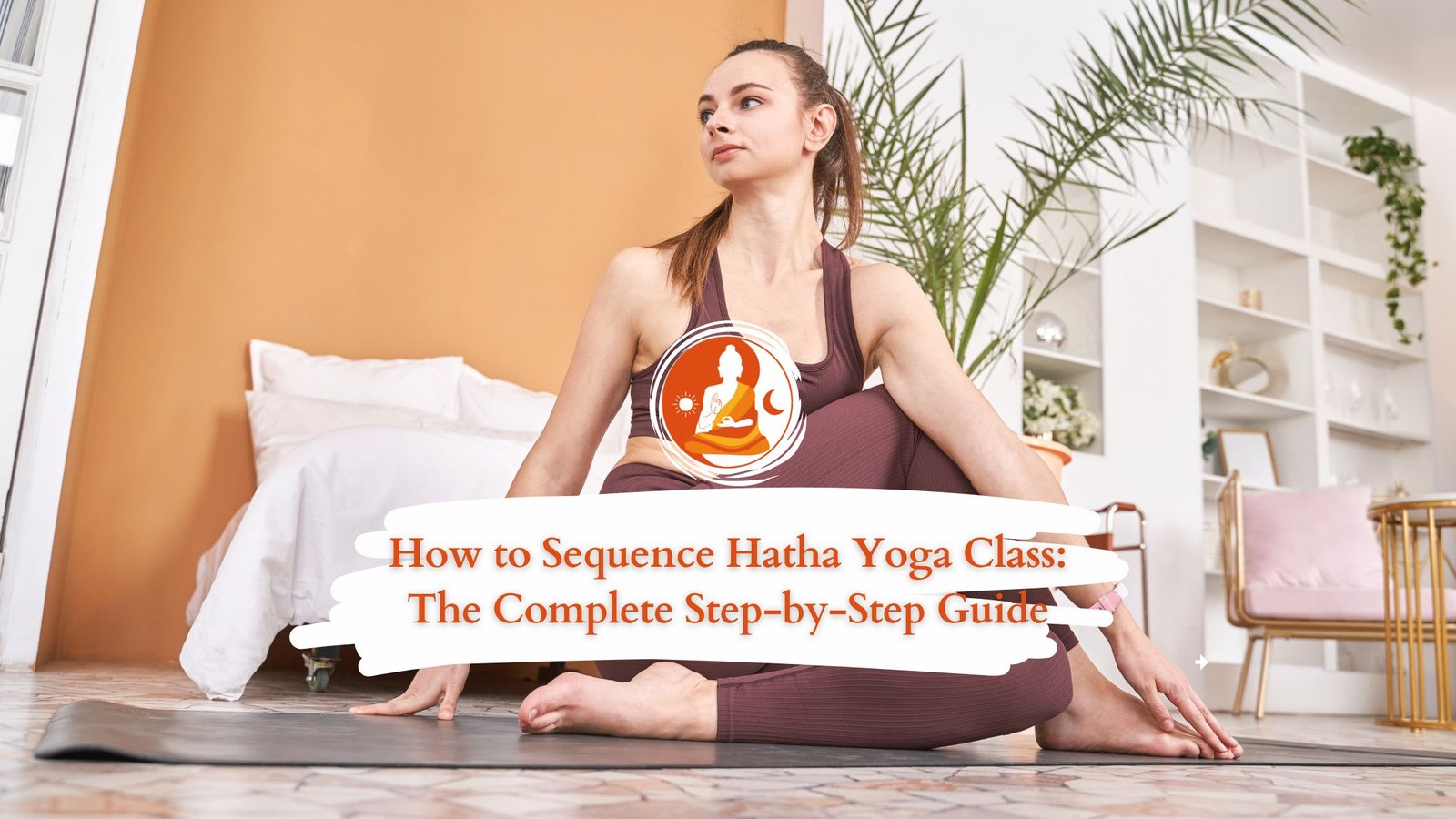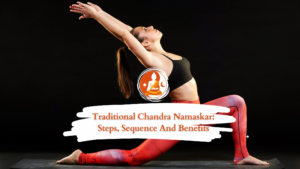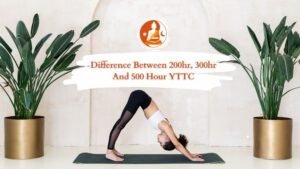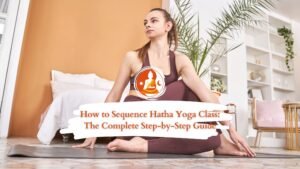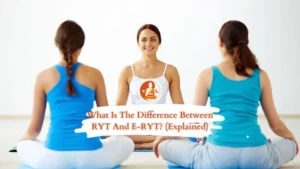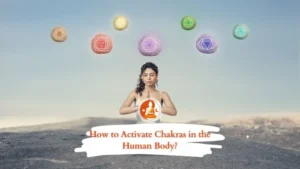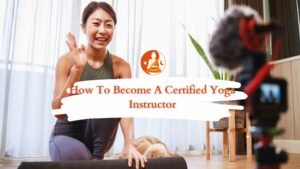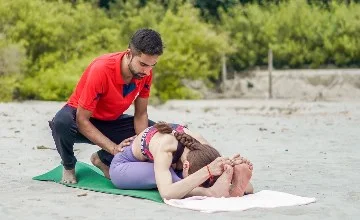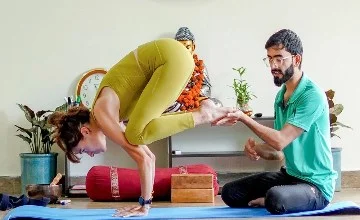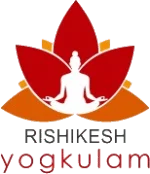Hatha yoga is one of the oldest forms of yoga practised all over the world. It’s popularly known for its focus on physical postures (asanas), breath control (pranayama), and meditation. A properly sequenced hatha yoga class is very important for maximizing benefits and ensuring a well-balanced and safe practice. This guide will show you how to sequence a hatha yoga class from warm-up to cool-down, ensuring a holistic and enjoyable yoga practice.
Table of Contents
ToggleWhat is Hatha Yoga?
Hatha Yoga is a branch of yoga that focuses on physical postures (hatha yoga poses), breath control, and meditation. The term “Hatha” combines “Ha” which means sun and “Tha” which means moon, symbolizing the balance of opposite forces within the body.
Hatha yoga originated in ancient India, the purpose of this practice was to prepare the body for deeper practices like meditation. Some of the key texts of hatha yoga are “Hatha Yoga Pradipika” and “Gheranda Samhita” which highlight some asana postures and meditation techniques.
There are many health benefits of practicing hatha yoga, some of the major benefits are improved flexibility, strength, balance and mental clarity. It also promotes deep relaxation and reduces stress.
Difference Between Hatha Yoga and Hatha Flow
Hatha yoga is focused on detailed instruction with longer holding of each posture and steady breath throughout the class. These classes focus on maintaining the stillness in the body and mind,allowing the students to take their time to develop the awareness, focus, strength and flexibility. While hatha flow also aims to achieve similar results but at a slightly quicker pace.
Students move from one posture to the next with breath. As the pace of the class is faster then the hatha yoga classes, it leaves less time to students for aligning and adjusting themselves, so if you are familiar with basic hatha yoga poses like hatha yoga sun salutations, warrior series, seated forward bends, triangle pose etc, you can enjoy the practice without any difficulty.
The benefits of hatha flow are they help to build endurance, strength, and improve body-mind connection with flexibility. Despite all this the fast-paced hatha flow can have moments of stillness just as the traditional hatha can have moments of some dynamic flow.
Hatha Yoga Poses
Traditionally there are 15 hatha yoga poses described in the Hatha Yoga Pradipika and 32 poses mentioned in the Gheranda Samhita. Other scriptures suggest that the number of yoga postures is as vast as the number of species in existence. Most of the yoga poses practised in modern times can be incorporated as asanas of hatha yoga.
How to Sequence a Yoga Class?
First, you need to understand the basics of sequencing to understand how to teach a yoga class effectively. Creating a yoga sequence means knowing how to arrange the poses smoothly in a progressive manner. By including these fundamentals you can easily learn how to sequence a yoga class that is balanced and engaging.
- Balance: A balanced sequence includes a variety of postures to work on different parts of the body, and avoid overworking or neglecting any muscle group.
- Symmetry in the Poses: Use symmetrical sequences to prevent imbalances in the body and promote even muscle development and flexibility.
- Progression in Your Sequence: Move from simple to more complex yoga poses gradually, allowing the body to prepare, prevent strain and enhance performance.
- Safety of Students: Safety is very important when creating a yoga sequence so focus on safety by paying attention to proper alignment and sufficient warm-up to minimize the risk of injury.
Designing a hatha yoga class means knowing your students and the purpose of their practice.
Hatha Yoga Sequence
When creating a Hatha yoga sequence, we often follow a technique widely used in both traditional and modern hatha yoga classes. This method is so simple, easy and effective that it is suitable for both beginners and advanced practitioners.
To create a balanced Hatha yoga sequence, follow these building blocks:
- Standing Sequence
- Kneeling Sequence
- Sitting Sequence
- Prone Sequence
- Supine Sequence
- Inversion
- Relaxation
Include 3-5 poses in each section arranged progressively. This ensures that your sequence flows smoothly and effectively. You can find many poses in yoga books or online to help you build your own Hatha yoga sequence.
Different Levels of Hatha Yoga Classes
1) Hatha Yoga Classes for Beginners: For beginner level hatha yoga class focus on basic poses with proper alignment and breathing this will help beginners to follow the class smoothly and they can build a strong foundation for their further journey.
2) Hatha Yoga Classes for Intermediate: In intermediate level hatha yoga class try to introduce more complex poses and transitions with moderate pace so it can give enough challenge to your student so they can enjoy this level of practice.
3) Hatha Yoga Classes for Advance: Add more challenging poses or transitions into your class. Have longer holding of the poses with proper breathing to go deeper into your stretch.
4) Specialized Classes: Tailor the specific needs of your students to achieve their desired results. Such as prenatal yoga, yoga for athletes or restorative yoga.
Preparation Before Class Starts
- Setting Environment: Make sure that you choose a quiet and clean, and properly ventilated space. Make sure that the room is free from distractions.
- Props Setting: Make sure that you have all necessary props like yoga mats, blocks, staraps, blankets and cushions. These props help during the challenging asana practice.
- Setting Intentions: Encourage students to set a personal intention for their practice before starting the class, this helps them to develop a deeper connection and purpose of the practice or you can also try to set the intention for the class as well.
Hatha Yoga Sequence for Beginners
Creating a hatha yoga sequence for beginners needs some basic yoga poses that focus on gentle stretching with deep breathing and relaxation. Here is a sample of the hatha yoga sequence that can be practised by beginners.
Gentle Hatha Yoga Sequence
Creating a gentle hatha yoga sequence focuses on simple poses, slower movements, longer holds, and mindful breathing to ensure a relaxing and rejuvenating yoga practice. Here’s a 1-hour gentle hatha sequence suitable for all levels, especially beginners and those who are looking for gentle yoga practice.
One-Hour Gentle Hatha Yoga Sequence For Beginners
1. Warm-Up (with light joint movements, you can spend five to seven minutes on simple warm-ups)
- Child’s Pose (Balasana): 30 seconds
- Cat-Cow Pose (Marjaryasana-Bitilasana): 2-3 minutes or 2-3 rounds withholding 5-10 Breaths or seconds.
2. Gentle Hatha Yoga Sun Salutation (5 Rounds at Slow Pace)
- Pranamasana (Prayer Pose): Normal Inhale and exhale.
- Hasta Uttanasana (Raised Arms Pose): Inhale and raise arms overhead.
- Pada Hastasana (Standing Forward Bend): Exhale and fold forward.
- Ashwa Sanchalanasana (Equestrian Pose): Inhale right leg back.
- Parvatasana (Mountain Pose): Exhale left leg back.
- Ashtanga Namaskara (Salute With Eight Parts): Inhale knees down, exhale chest and chin down.
- Cobra Pose (Bhujangasana): Inhale and lift the chest.
- Parvatasana (Mountain Pose): Exhale back to the mountain.
- Ashwa Sanchalanasana (Equestrian Pose): Inhale left leg forward.
- Pada Hastasana (Standing Forward Bend): Exhale fold forward.
- Hasta Uttanasana (Raised Arms Pose): Inhale and raise arms overhead.
- Pranamasana (Prayer Pose): Exhale pranamasana
3. Standing Sequence (8-10 minutes)
- Equal standing pose (Samasathi): 30 seconds to catch your breath
- Tree Pose (Vrksasana): 30 seconds on each side, repeat more than once with different variation
- Triangle Pose (Trikonasana): 30-40 seconds on each side
- Warrior I (Virabhadrasana I): 30-40 seconds on each side
- Warrior II (Virabhadrasana II): 30-40 seconds on each side
- Standing Forward Bend (Uttanasana): 30-40 seconds on each side
4. Kneeling Sequence (6-7 minutes)
- Cat-Cow Pose (Marjaryasana-Bitilasana): 30-40 seconds on each side, you can add more variations
- Gate Pose (Parighasana): 30-40 seconds on each side
- Low Lunge (Anjaneyasana): 30-40 seconds on each side, you can add more variations
- Child’s Pose (Balasana): 30 seconds
5. Sitting Sequence (7-8 minutes)
- Seated Forward Bend (Paschimottanasana): 30-40 seconds, you can add more variations
- Reverse Plank Pose (Purvottanasana): 30-40 seconds on each side, you can add more variations
- Head-to-Knee Forward Bend (Janu Sirsasana): 30-40 seconds on each side, you can add more variations
- Bound Angle Pose (Baddha Konasana): 30-40 seconds on each side, you can add more variations
6. Prone Sequence (5-7 minutes)
- Cobra Pose (Bhujangasana): 30-40 seconds, you can add more variations
- Sphinx Pose (Salamba Bhujangasana): 30-40 seconds, you can add more variations
- Child’s Pose (Balasana): 30 seconds to relax your lower back
7. Supine Sequence (10 minutes)
- Bridge Pose (Setu Bandhasana): 30-40 seconds, you can add more variations
- Supine Twist (Supta Matsyendrasana): 4 minutes (2 minutes on each side)
- Happy Baby Pose (Ananda Balasana): 2 minutes
- Knees to Chest Pose (Apanasana): 2 minutes
8. Relaxation (10 minutes)
- Corpse Pose (Savasana): 10 minutes
Additional Tips:
- Transitions: Move slowly and mindfully between the poses, use your breath as a tool to guide you during each transition.
- Breathing: Focus on deep and longer breaths, maintaining the steady breathing throughout the practice is very important, emphasize on long exhales to experience deep relaxation.
- Alignment: Pay attention to proper alignment of the posture, use props like blocks and straps if needed to support your body.
- Modifications: Offer various modifications for any challenging posture to accommodate different levels of students.
This gentle Hatha yoga sequence is designed to provide a calming and restorative experience, enhancing flexibility, and promoting a sense of peace and well-being. Adjust the timings and poses based on the specific needs and abilities of your students.
Intermediate Hatha Yoga Sequence
Creating an intermediate Hatha Yoga sequence needs a combination of foundational poses along with some challenging poses to build strength, flexibility, and balance. Here’s a well-rounded sequence which you can follow:
One-Hour intermediate Hatha Yoga Sequence For 1-3 year experience practitioner
1. Warm-Up (with light joint movements, you can spend five to seven minutes on simple warm-ups)
- Child’s Pose (Balasana): 30 seconds
- Shashank Bhujangasana (Striking cobra Pose): 1-3 minutes or 2-3 rounds without holding.
- Child pose to mountain pose (Parvatasana)
- Walk forward to half way bend forward
- Padahastasana (Hand to Foot Pose)
- Come to Tadasana
2. Hatha Yoga Sun Salutation (5 Rounds at moderate Pace)
- Pranamasana (Prayer Pose): Normal Inhale and exhale
- Hasta Uttanasana (Raised Arms Pose): Inhale and raise arms overhead.
- Pada Hastasana (Standing Forward Bend): Exhale and fold forward.
- Ashwa Sanchalanasana (Equestrian Pose): Inhale right leg back.
- Parvatasana (Mountain Pose): Exhale left leg back.
- Ashtanga Namaskara (Salute With Eight Parts): Inhale knees down, exhale chest and chin down.
- Cobra Pose (Bhujangasana): Inhale and lift the chest.
- Parvatasana (Mountain Pose): Exhale back to the mountain.
- Ashwa Sanchalanasana (Equestrian Pose): Inhale left leg forward.
- Pada Hastasana (Standing Forward Bend): Exhale fold forward.
- Hasta Uttanasana (Raised Arms Pose): Inhale and raise arms overhead.
- Pranamasana (Prayer Pose): Exhale pranamasana
3. Standing Sequence (8-10 minutes)
- Swaying palm tree poseTiryaka tadasana): 30 seconds to stretch your side body
- Hand to foot pose (Padahastasana): 30 seconds
- Crescent Moon Pose(Anjaneyasana): 30-40 seconds on each side
- Warrior I (Virabhadrasana I): 30-40 seconds on each side
- Warrior II (Virabhadrasana II): 30-40 seconds on each side
- Warrior III (Virabhadrasana III): 30-40 seconds on each side
- Chair Pose (Utkatasana): 30-40 seconds on each side
- Eagle Pose (Garudasana) : 30-40 seconds on each side
4. Kneeling Sequence (6-7 minutes)
- Cat-Cow Pose (Marjaryasana-Bitilasana): 30-40 seconds on each side, you can add more variations
- Low Lunge (Anjaneyasana): 30-40 seconds on each side, you can add more variations
- Ardha Hanumanasana (Half Splits Pose): 30-40 seconds on each side, you can add more variations
- Simha Garjana Asana (Roaring Lion Pose): 1 – 3 rounds
- Child’s Pose (Balasana): 30 seconds
5. Sitting Sequence (7-8 minutes)
- Seated Forward Bend (Paschimottanasana): 30-40 seconds, you can add more variations.
- Reverse Plank Pose(Purvottanasana): 30-40 seconds on each side, you can add more variations.
- Head-to-Knee Forward Bend (Janu Sirsasana): 30-40 seconds on each side, you can add more variations.
- Half Lord of the Fishes Pose (Ardha Matsyendrasana): 30-40 seconds on each side, you can add more variations.
- Bound Angle Pose (Baddha Konasana): 30-40 seconds on each side, you can add more variations.
- Legs Spread back stretch pose (Pada Prasar Paschimottanasana): 30-40 seconds on each side, you can add more variations.
6. Prone Sequence (5-7 minutes)
- Cobra Pose (Bhujangasana): 30-40 seconds, you can add more variations
- Bow Pose (Dhanurasana): 30-40 seconds, 2 rounds
- Child’s Pose (Balasana): 30 seconds to relax your lower back
7. Supine Sequence (10 minutes)
- Bridge Pose (Setu Bandhasana): 30-40 seconds, you can add more variations.
- Wheel pose (Chakrasana): 30-40 seconds, you can add more variations like elbow down wheel pose.
- Knees to Chest Pose (Apanasana): 2 minutes
- Supine Twist (Supta Matsyendrasana): 4 minutes (2 minutes on each side)
- Happy Baby Pose (Ananda Balasana): 2 minutes
8. inversion (10 minutes)
- Supported Headstand (Salamba Sirsasana): 30-40 seconds, you can add more variations
9. Relaxation (10 minutes)
- Corpse Pose (Savasana): 10 minutes
Tips for Effective Teaching
- Communication: Use simple and concise words and language to avoid any miscommunication. Each posture should be explained clearly with its benefits and contraindication.
- Observation: Pay close attention to each student and give personalized feedback, suggestions and adjustments.
- Encouragement: Create a supportive environment where students feel encouraged to explore their practice.
Music and Ambiance
- Creating Atmosphere: To create a peaceful environment use nice lighting, incense stick or canted candles for nice aroma around to create a peaceful environment.
- Music Selection: choose the music that compliments the energy of the class. Generally instruments and nature sound works really well.
- Sound Healing: incorporate sound healing tools such as signings bowls, chimes or gongs to give more relaxaching experience.
Post Class Reflection and Feedback
Reflecting on your classes is a very helpful tool to improve your upcoming sessions. Take feedback from the students about your class, take some valuable insights from it and then improve it. You can do group discussions or one on one conversations to understand the feedback of the students and identify the areas of improvement.
FAQs About Sequencing Hatha Yoga Classes
A: Warm up the body with some easy joint movements along with breathing exercises to prepare the class.
A: This is absolutely different from class to class and from person to person. Usually you can do 10-15 min or warm up and 30-40 minutes of the main sequence and 10-15 minutes of cooling down.
A: Give them options to do and let them focus on their own body and listen to it. This is very important if a student is suffering from an injury to give them modification or other options.
A: Use methods like slower and deep breathing with some guided relaxation techniques to give them a meditation experience.

